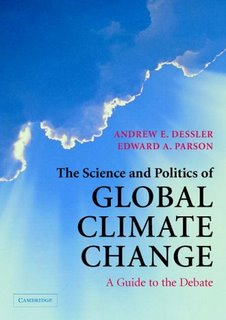
The Science and Politics of Global Climate Change: A Guide to the Debate, Andrew E. Dessler and Edward A. Parsons, Cambridge University Press, 2006
It is bewildering at times to examine the scientific literature on climate change. This is not to suggest that the evidence for human induced (anthropogenic) climate change is not clear, but there is so much of it. The spin of the sceptics makes nefarious use of ambiguities, uncertainties and work in progress. It becomes worse when we enter the world of policy. Given that anthropogenic climate change is a reality, how should we respond? What policies should be made now?
Dessler and Parsons do a pretty good job at surveying the science and the policy debate until now. As a scientist, the policy can drift over my head, but it is important to understand the difficulties in decision-making, as well as the mendacity involved.
Chapter 1 presents a brief background to the science, the rhetoric of the sceptics and policy history. Chapter 2 provides a useful distinction when approaching the debate. Science deals with positive claims – it is raining, greenhouse gases have warmed the climate, smoking causes cancer. These positive claims may be used as hypotheses to test, argued about in the peer-reviewed literature (p26), which they claim as a power filter for bad science (though I seem to recall a Nature article suggesting much nonsense still gets published and repeatedly (mis)quoted). It does a fair job, and when a particular view dominates the literature, consensus, not conspiracy is the likely reason (Miranda Devine of the Sydney Morning Herald take note). It should be noted (as Dessler & Parsons do) that fair reporting of the issues doesn’t mean giving equal space to the fringe sceptics (and I say fringe because the consensus is warming) – this isn’t balance, this is trying to sell papers.
Policy, ethics, philosophy and religion deal with normative claims – how should things be? Hence, global warming due to greenhouse gases from human activities is thinning and melting the artic ice caps is a positive statement. That we should seek to preserve the Inuit lifestyle or conserve polar bears because they have a right to exist is a normative statement.
Problems occur when the two are (invariably) mixed. When scientists make normative claims, these claims may be provoked by their positive claims, but they are now speaking as citizens and not scientists per se. Personally, I fully support a scientist making a normative claim so long as it is clear this is what is being said (and likewise for politicians, journalists, etc). Dessler and Parsons note that these two come together necessarily in scientific assessments (like IPCC groups II & III).
Chapter 3 is a good summary of the science, with the various climate proxies (ice cores, corals, tree rings, etc) mentioned with a discussion of the uncertainties. Various mechanisms are discussed and dismissed as being the cause of the current warming. Also discussed are the various scenarios used in the IPCC assessment. These are a source of uncertainty that sceptics often ignore. Yes, there are uncertainties in the science as to some feedbacks. There is also great uncertainty as to how humanity will modify its behaviour in terms of emissions. I suspect that it will take a big stick to make many nations reduce emissions in a dramatic sense. Furthermore, whereas I don’t demonise technology, as a Christian I certainly don’t worship it and don’t expect it to save us all. There will be more that technological fixes required to solve our energy needs and climate woes.
Chapter 4 continues to examine emission scenarios by looking at adaptation (how will we cope – well fine for rich countries but Bangladesh, the Pacific Islands and polar bears?), mitigation (changes we need to make now – like fund alternate energy research please Mr Howard, not just your coal mates) and geoengineering (the wishful, technology worship). Dessler and Parsons come out on the side of start mitigation now, it will cost us less in the long run. Insurance is a good analogy, you pay for what you don’t expect and certainly hope will not happen just in case it does. Given what is expected for climate change, what is a few % GDP?
Chapter 5 will be hard going for the non-policy types. Essentially, they hold out hope for a Kyoto like arrangement, an internationally coordinated effort some time down the track. Making people pay for what they emit is seen as a powerful motivator to cap emissions. Likewise, whilst waiting for everyone to play together, they put their hope in bilateral agreements such as between China and the USA. An interesting observation in this chapter (see also Global Warming: A Very Short Introduction, Mark Maslin) is that those who readily accept the need for regulation are more likely to accept the evidence for climate change and hence the need to act, as opposed to the free marketeers of the world. Given that the free marketeers often seem to be in control, we are in trouble.
This book makes for good reading for those who might be interested in getting into the process rather than merely cheering or booing from the sidelines. Given the cognitive/ideological divide mentioned above, presenting facts will never be enough (until it is too late?). Furthermore, books like The Weather Makers (Tim Flannery) and Climate Change Begins at Home (Dave Reay) give us something to do ourselves whilst waiting and agitating for the sea change at the top.
No comments:
Post a Comment